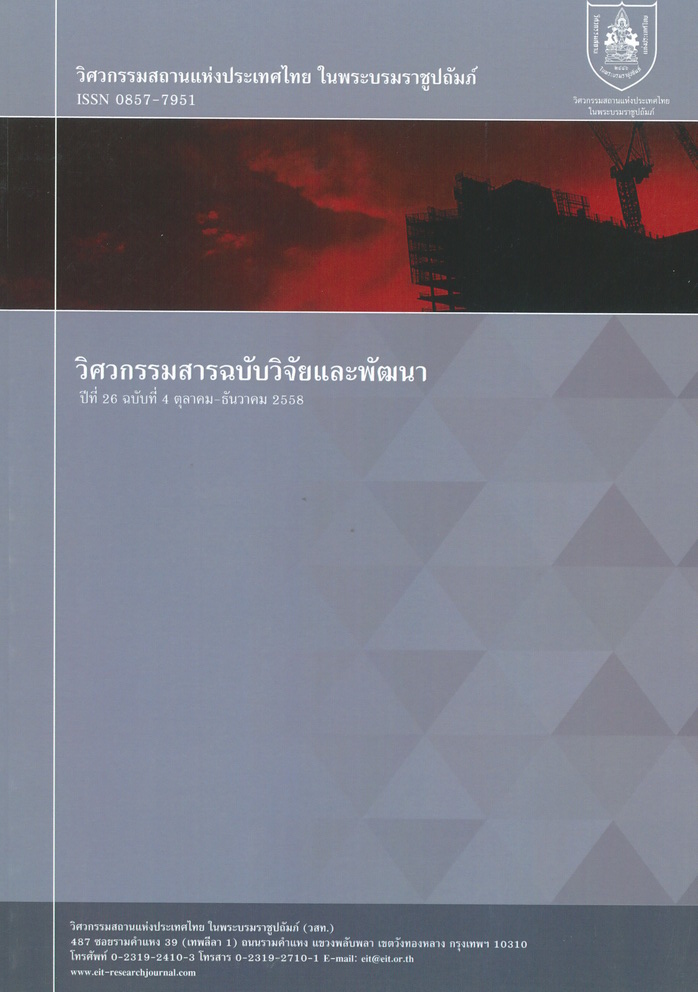ANALYSIS OF BUFFER AREAS OF VOLATILE ORGANIC COMPOUNDS FACTORIES
Main Article Content
Abstract
งานวิจัยนี้มีวัตถุประสงค์เพื่อวิเคราะห์หารัศมีและรูปแบบของพื้นที่กันชนสำหรับโรงงานที่ประกอบกิจการเกี่ยวกับสารประกอบอินทรีย์ไอระเหย โดยพิจารณาเป็น 2 กรณี คือ กรณีที่ 1 เกิดการรั่วไหลจากถังเก็บในสภาพภูมิอากาศที่เกิดขึ้นบ่อยและกรณีที่ 2 เกิดการรั่วไหลจากถังเก็บในสภาพภูมิอากาศที่ส่งผลให้เกิดสถานการณ์เลวร้าย ในงานวิจัยนี้ได้ใช้โปรแกรม ALOHA ช่วยในการวิเคราะห์ ผลการวิจัยพบว่าประเทศไทยมีสภาพภูมิอากาศที่เกิดขึ้นบ่อยที่ความเร็วลมเท่ากับ 1 เมตรต่อวินาที อุณหภูมิในช่วง 26–30 องศาเซลเซียส ปริมาณเมฆปกคลุม 0-8 ส่วนของท้องฟ้าส่งผลให้มีรัศมีการแพร่กระจายของความเข้มข้นของสารประกอบอินทรีย์ไอระเหยขั้นต่ำที่ทำให้เสียชีวิต (AEGLs) ในกรณีของสารอะคริโลไนไตรท์ สารเบนซีน และสารบิวทาไดอีน เป็น 1.6 กิโลเมตร, 275 เมตร และ 936 เมตร ตามลำดับ ในขณะที่สภาพภูมิอากาศที่ส่งผลให้เกิดสถานการณ์เลวร้ายที่ความเร็วลมเท่ากับ 1 เมตรต่อวินาที อุณหภูมิอยู่ในช่วง 36–40 องศาเซลเซียส ปริมาณเมฆปกคลุม 0-8 ส่วนของท้องฟ้า มีรัศมีการแพร่กระจายของความเข้มข้นของสารประกอบอินทรีย์ไอระเหยขั้นต่ำที่ทำให้เสียชีวิต ในกรณีสารอะคริโลไนไตรท์ สารเบนซีน และสารบิวทาไดอีน เป็น 1.9 กิโลเมตร, 331 เมตร และ 939 เมตร ตามลำดับ ทั้งนี้มีรูปแบบของพื้นที่กันชนสัมพันธ์กับระยะการแพร่กระจายในทิศตั้งฉากกับทิศทางลม
The objective of this research was to analyze the radius and type of buffer areas for Volatile Organic Compounds (VOCs) factories. The leak of Volatile Organic Compounds from the storage tank was considered in common climate and the worst case of climatic conditions by using ALOHA. The results showed that Thailand’s climate frequently occurred at wind speed 1 m/s, temperatures in range 26-30°C, and the proportion of cloud cover on the sky in range 0–8. The radius of dispersion of Volatile Organic Compounds from Acute Exposure Guideline Levels (AEGLs) in case of Acrylonitrile, Benzene and Butadiene were 1.6 kilometers, 275 meters and 936 meters respectively. While the worst case of climatic conditions were at wind speed of 1 m/s, temperatures in range of 36-40°C and the proportion of cloud cover on the sky in range 0–8. The radius of dispersion of Acrylonitrile, Benzene and Butadiene were 1.9 kilometers, 331 meters and 939 meters respectively. Moreover, Types of buffer areas were related to distance of dispersion in perpendicular with wind direction.
Article Details
The published articles are copyright of the Engineering Journal of Research and Development, The Engineering Institute of Thailand Under H.M. The King's Patronage (EIT).


